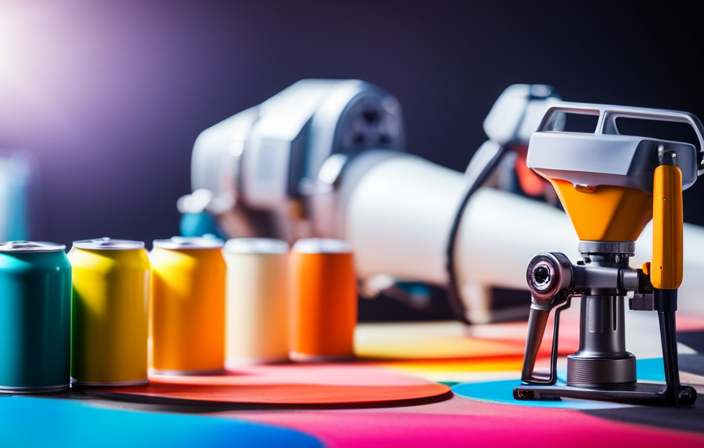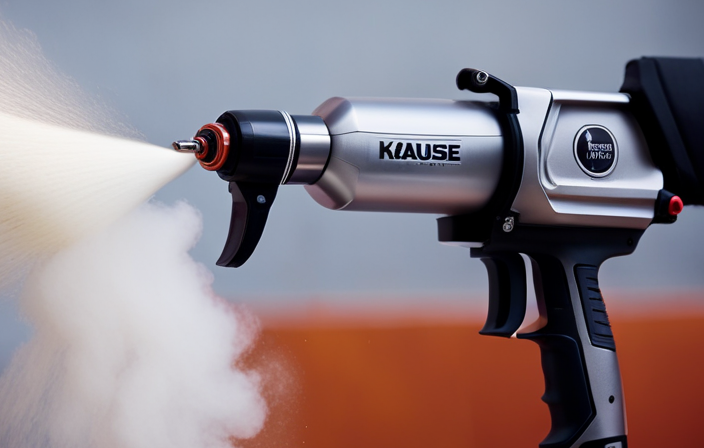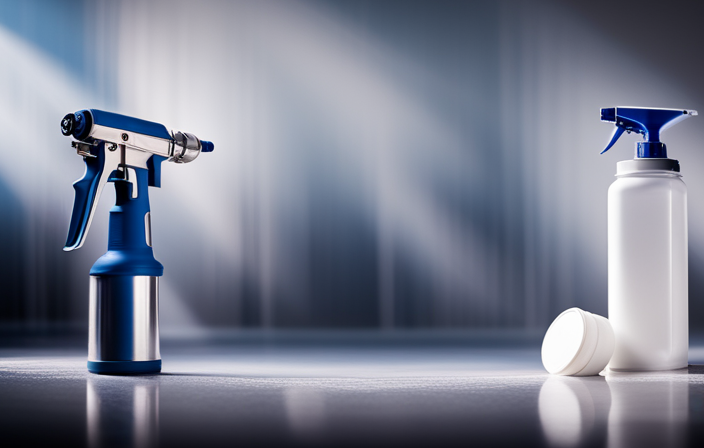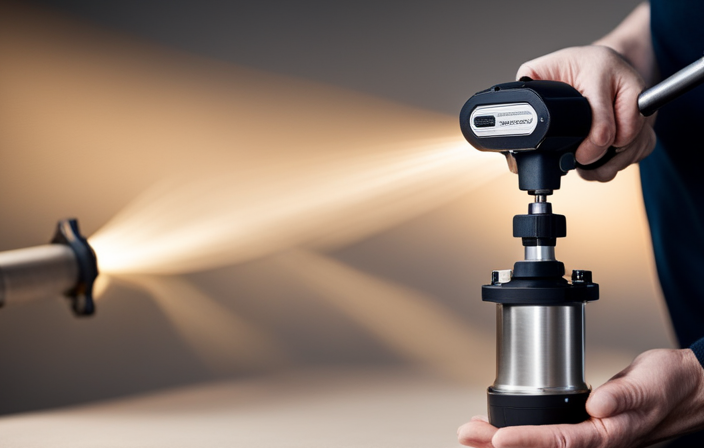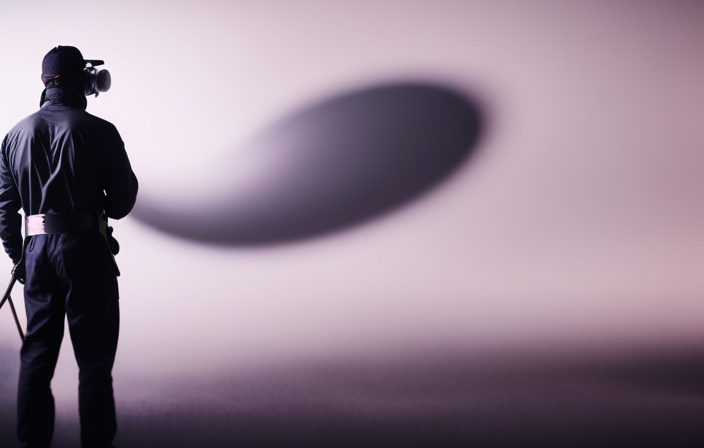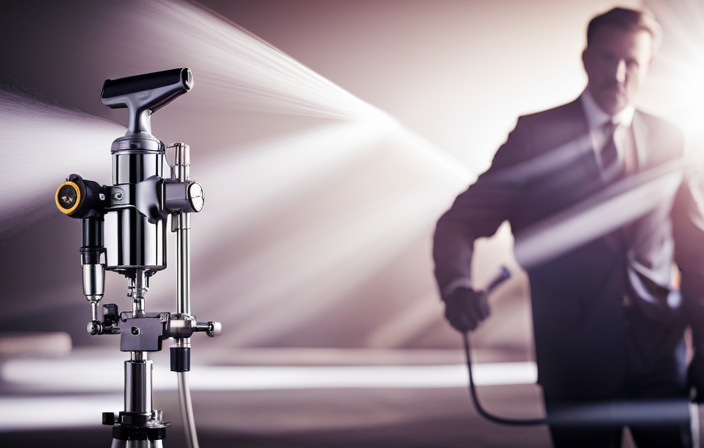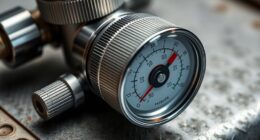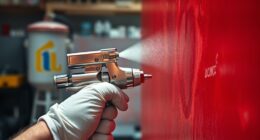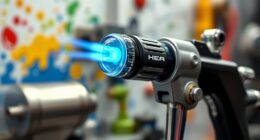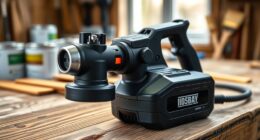You now have an airless paint sprayer ready for your painting project. But the important question is: how much paint will you actually require? I’m familiar with the frustration of running out of paint mid-project because I’ve been there too. So, my goal is to help you figure out precisely how much paint you need to use your airless paint sprayer effectively.
In this article, we’ll dive into the basics of an airless paint sprayer and break down the steps to calculate the surface area to be painted. We’ll also discuss the paint coverage rate, the number of coats required, and even factors like overspray and wastage.
Plus, we’ll consider the efficiency of your paint sprayer and how that affects the overall paint quantity needed.
By the end of this article, you’ll have all the knowledge and tips you need to confidently buy the right amount of paint for your airless paint sprayer.
So let’s get started and make sure you never run out of paint again!
Key Takeaways
- Consider the surface texture to accurately estimate the amount of paint needed for an airless paint sprayer.
- Research different brands’ coverage rates to ensure sufficient paint coverage.
- Familiarize yourself with the paint sprayer settings, such as pressure, flow rate, nozzle sizes, and spray patterns, to achieve desired outcomes.
- Choose a brand that offers good coverage and durability for long-lasting and professional results.
Understanding the Basics of an Airless Paint Sprayer
So, you’re ready to dive into the world of airless paint sprayers and learn the basics, huh? Well, let’s start by understanding how this powerful tool operates.
When using an airless paint sprayer, it’s important to calculate paint consumption accurately. This will help you determine how much paint you need for your project, saving you time and money.
Another crucial factor to consider is understanding paint viscosity. The viscosity of the paint affects the spray pattern and determines how well it will flow through the sprayer. By knowing the viscosity, you can adjust the pressure and nozzle size accordingly.
Now, let’s move on to the next section about calculating the surface area to be painted.
Calculating the Surface Area to be Painted
To accurately determine the amount of paint required for an airless paint sprayer, it’s essential to calculate the surface area that needs to be painted. This step is crucial in estimating paint usage and ensuring that you have enough paint for the job.
To calculate the surface area, you need to measure the height and width of each wall or surface that will be painted and multiply them together. Don’t forget to subtract any doors or windows from the total area.
Additionally, consider the texture of the surface, as rougher surfaces may require more paint.
Once you have the surface area calculated, you can move on to determining the paint coverage rate, which will help you determine how much paint you will need.
Determining the Paint Coverage Rate
Determining the paint coverage rate allows me to accurately estimate the amount of paint required, ensuring a smooth and efficient painting process that leaves no surface untouched. When calculating paint usage, there are several factors to consider:
- Surface texture: Rough surfaces tend to absorb more paint, while smoother surfaces require less.
- Paint type: Different types of paint have varying coverage rates. It’s important to refer to the manufacturer’s instructions for the specific paint being used.
- Application method: The coverage rate may differ depending on whether a brush, roller, or airless paint sprayer is being used.
- Number of coats: Multiple coats may be necessary to achieve full coverage, which can increase the amount of paint needed.
- Waste and overspray: It’s important to account for any potential waste or overspray during the painting process.
Considering the number of coats is the next step in estimating the paint needed for an airless paint sprayer.
Considering the Number of Coats
When using an airless paint sprayer, it is important to consider the number of coats needed for a flawless finish. Calculating paint costs and optimizing paint usage is crucial for a cost-effective painting project.
Determining the number of coats required depends on several factors, including the type of surface, paint color, and desired coverage. Generally, lighter colors or previously painted surfaces may only require one coat, while darker colors or bare surfaces may need multiple coats.
Accurately estimating the number of coats needed can help you avoid purchasing excess paint and save money. However, it is also important to account for overspray and wastage when calculating the overall paint quantity. This ensures that you have enough paint to finish the job without running out midway.
Adjusting for Overspray and Wastage
Calculating for overspray and wastage is essential to ensure that you have enough paint to complete your project without any interruptions. For example, imagine spending hours meticulously painting your living room, only to run out of paint before you finish the last wall, resulting in an incomplete and unsatisfying end result.
To reduce overspray and minimize wastage, consider the following:
- Use drop cloths and masking tape to protect areas not being painted.
- Adjust the pressure on the airless paint sprayer to control the amount of paint being sprayed.
- Practice proper spraying techniques, such as maintaining a consistent distance from the surface and using smooth, even strokes.
By taking these measures, you can significantly reduce the amount of paint lost to overspray and achieve a more efficient and cost-effective painting process.
Now, let’s move on to the next section and discuss choosing the right paint type and thickness.
Choosing the Right Paint Type and Thickness
To ensure a flawless and long-lasting paint job, it’s crucial for you to carefully select the perfect paint type and thickness. When choosing paint colors, consider the specific needs of your project.
Different paint types have different properties, such as durability and resistance to moisture or stains. Understanding paint viscosity is also important. Viscosity refers to the thickness or consistency of the paint. It affects how smoothly the paint flows through the sprayer and how it adheres to the surface.
Thicker paint may require a larger nozzle or more pressure to achieve proper atomization. On the other hand, thinner paint may result in excessive overspray. By choosing the right paint type and viscosity, you can optimize the performance of your airless paint sprayer.
This leads us to the next step of factoring in the paint sprayer’s efficiency.
Factoring in the Paint Sprayer’s Efficiency
Take into account the astonishing efficiency of your paint sprayer to achieve outstanding results. The paint sprayer’s performance plays a crucial role in optimizing paint usage.
A high-quality airless paint sprayer can provide excellent coverage with minimal overspray, allowing you to use less paint compared to traditional methods. The sprayer’s powerful pressure ensures even distribution and smooth application, resulting in a professional finish.
By utilizing the sprayer’s efficiency, you can save both time and money on paint. However, it is essential to consider the specific paint type and thickness, as well as adjust the sprayer settings accordingly for optimal performance.
Estimating the paint quantity needed is the next step, which involves calculating the surface area to be painted and factoring in any additional coats required for proper coverage.
Estimating the Paint Quantity Needed
To accurately estimate the amount of paint you’ll need, consider the size of the area to be painted and the number of coats required. This estimation is crucial when operating an airless paint sprayer. The coverage rate of paint can vary depending on factors such as the type of surface, its texture, and the type of paint used. Rough or porous surfaces may require more paint for full coverage, and certain types of paint have higher coverage rates than others. Taking these factors into account will ensure you purchase the right amount of paint for your project. Considering these factors is important to avoid unnecessary expenses when buying the right amount of paint.
Tips for Buying the Right Amount of Paint
When purchasing paint, it’s important to avoid ending up with an absurd surplus of gallons that could cover an entire skyscraper. To buy the right amount of paint, there are a few things you should consider.
First, choose the right brand that suits your needs. Different brands may have different coverage rates, so it’s important to do some research beforehand.
Secondly, take into account the surface texture you’ll be painting. Rough surfaces usually require more paint than smooth ones.
In terms of the nested bullet point list, here are two sub-lists to help guide your purchasing decision:
-
Consider the brand:
-
Look for trusted brands with good reviews.
-
Consider any specific requirements, such as eco-friendly options.
-
Evaluate the surface texture:
-
Determine if the surface is smooth or rough.
-
Measure the surface area accurately to avoid over or underestimating.
Taking the time to consider the brand and the surface texture will help you avoid unnecessary waste and save money.
In the next section, we will provide some final thoughts and recommendations for using an airless paint sprayer effectively.
Final Thoughts and Recommendations
To ensure a successful and efficient painting project, it’s important to consider some final thoughts and recommendations.
When buying quality paint for your airless paint sprayer, make sure to choose a brand that offers good coverage and durability. This will ensure that your paint job looks great and lasts a long time.
Additionally, it’s crucial to understand the settings on your paint sprayer. Take the time to familiarize yourself with the different pressure and flow rate options, as well as the nozzle sizes and spray patterns. Adjusting these settings correctly can make a significant difference in the outcome of your project.
By buying quality paint and understanding your paint sprayer settings, you’ll be well-equipped to achieve professional-looking results with your airless paint sprayer.
Frequently Asked Questions
Can an airless paint sprayer be used for any type of paint?
Yes, airless paint sprayers can be used for automotive painting. The advantages of using an airless paint sprayer for interior painting include faster application, even coverage, and less overspray compared to traditional methods.
How long does it typically take for the paint to dry when using an airless paint sprayer?
The paint drying time with an airless paint sprayer can vary depending on factors such as humidity, temperature, and type of paint used. It typically takes about 1-2 hours for the paint to dry completely.
Are there any safety precautions that should be taken when operating an airless paint sprayer?
When operating an airless paint sprayer, it is crucial to prioritize safety. This includes proper maintenance and cleaning of the sprayer, as well as wearing protective gear such as goggles, gloves, and a respirator.
Can an airless paint sprayer be used on textured surfaces?
Using an airless paint sprayer on rough surfaces is a breeze! It effortlessly covers every nook and cranny, saving time and effort. The benefits of using it on textured walls? Flawless coverage and a professional finish.
What is the average lifespan of an airless paint sprayer?
The average lifespan of an airless paint sprayer is typically around 5-7 years with proper maintenance. Regular cleaning, lubrication, and filter replacement are important to ensure optimal performance and longevity.
Conclusion
In conclusion, operating an airless paint sprayer requires careful calculation and consideration of various factors. By understanding the basics of the sprayer, calculating the surface area to be painted, and determining the paint coverage rate, you can estimate the paint quantity needed accurately.
Additionally, it is important to factor in overspray and wastage. These can vary depending on the skill level of the operator and the type of surface being painted. Taking these into account will help prevent running out of paint or having too much leftover.
It’s like baking a cake – you need the right measurements and ingredients to achieve the desired result. So, when buying paint, remember to take into account all these factors to ensure a smooth and successful painting project.
Happy painting!
